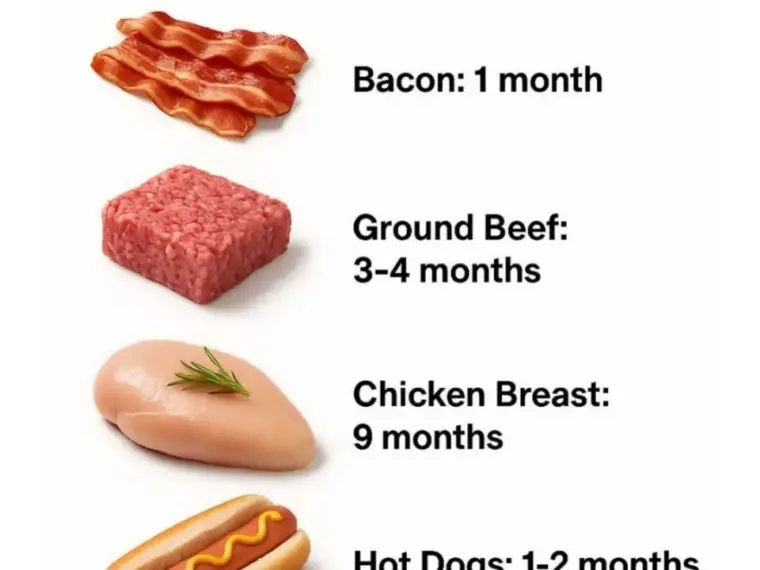Freezing meat is a common practice that helps preserve its freshness and extend its shelf life. However, not all meats are created equal when it comes to freezer storage. Understanding the optimal storage durations for different types of meat can ensure that you enjoy the best quality and flavor when you’re ready to cook. Proper storage techniques can also prevent freezer burn and maintain the nutritional value of the meat.
In this article, we will explore the recommended freezer storage durations for ten different types of meat. By following these guidelines, you can make the most of your freezer space and reduce food waste. Whether you’re dealing with beef, chicken, or more exotic meats like venison and duck, knowing how long each type can be stored will help you plan your meals and shopping trips more effectively.
1. Beef: Optimal Freezer Storage Duration
Beef is a versatile meat that can be stored in the freezer for varying lengths of time depending on the cut. Ground beef should ideally be used within 3 to 4 months for the best quality. Steaks and roasts, on the other hand, can last between 6 to 12 months if properly wrapped and stored at 0°F (-18°C) or lower. To prevent freezer burn, it’s crucial to use airtight packaging and remove as much air as possible.
For long-term storage, consider vacuum sealing beef cuts. This method not only extends the freezer life but also helps retain the meat’s moisture and flavor. Labeling the packages with the date of freezing can help you keep track of their storage duration.
2. Chicken: How Long Can It Last?
Chicken is a staple in many households, and freezing it can help ensure you always have some on hand. Whole chickens can be stored in the freezer for up to 1 year, while chicken parts such as breasts, thighs, and wings are best used within 9 months. For ground chicken, aim to use it within 3 to 4 months for optimal quality.
To maintain the chicken’s quality, wrap it tightly in plastic wrap or aluminum foil before placing it in a freezer bag. Removing as much air as possible will help prevent freezer burn. It’s also helpful to freeze chicken in portion sizes that suit your cooking needs, making it easier to thaw only what you need.
3. Pork: Preserving Quality in the Freezer
Pork can be a delicious addition to many meals, and freezing it properly ensures you can enjoy it at its best. Pork chops and roasts can be stored for 4 to 6 months, while ground pork should be used within 3 to 4 months. Bacon and sausage have a shorter freezer life, typically around 1 to 2 months, due to their higher fat content.
When freezing pork, it’s important to use moisture-proof and vapor-proof packaging to prevent freezer burn. Consider double wrapping the pork in plastic wrap and then placing it in a freezer bag. Labeling the packages with the date can help you manage your inventory and use the oldest items first.
4. Lamb: Freezing Guidelines for Freshness
Lamb is a flavorful meat that can be stored in the freezer for extended periods if done correctly. Lamb chops and roasts can last up to 6 to 9 months, while ground lamb is best used within 3 to 4 months. To preserve the quality of lamb, wrap it tightly in plastic wrap or aluminum foil and then place it in a heavy-duty freezer bag.
For best results, consider vacuum sealing lamb cuts to extend their freezer life and maintain their flavor. It’s also important to freeze lamb at 0°F (-18°C) or lower to ensure it remains safe to eat. Proper labeling with the date of freezing can help you keep track of how long the lamb has been stored.
5. Turkey: Storage Tips for Longevity
Turkey is often associated with holiday meals, but it can be enjoyed year-round if stored properly. A whole turkey can be kept in the freezer for up to 1 year, while turkey parts such as breasts and thighs are best used within 9 months. Ground turkey should be consumed within 3 to 4 months for the best quality.
To freeze turkey, wrap it tightly in plastic wrap or aluminum foil and then place it in a freezer bag. Removing as much air as possible will help prevent freezer burn. If you have a large turkey, consider cutting it into smaller portions before freezing to make it easier to thaw and cook later.
6. Fish: Ensuring Safety and Flavor
Fish is a delicate protein that requires careful handling when freezing. Fatty fish such as salmon and mackerel can be stored for up to 2 to 3 months, while lean fish like cod and haddock can last up to 6 months. To maintain the fish’s quality, wrap it tightly in moisture-proof packaging and remove as much air as possible.
Consider using vacuum sealing for fish to extend its freezer life and preserve its flavor. It’s also important to freeze fish at 0°F (-18°C) or lower to ensure it remains safe to eat. Labeling the packages with the date of freezing can help you keep track of their storage duration.
7. Shellfish: Maintaining Texture and Taste
Shellfish such as shrimp, crab, and lobster can be frozen to extend their shelf life, but they require special care to maintain their texture and taste. Raw shrimp can be stored for up to 6 months, while cooked shellfish should be used within 3 months. To freeze shellfish, place them in airtight containers or heavy-duty freezer bags.
For best results, consider freezing shellfish in a brine solution to help maintain their texture. It’s also important to freeze shellfish at 0°F (-18°C) or lower to ensure they remain safe to eat. Proper labeling with the date of freezing can help you manage your inventory and use the oldest items first.
8. Venison: Proper Freezing Techniques
Venison is a lean meat that can be stored in the freezer for extended periods if done correctly. Venison steaks and roasts can last up to 9 to 12 months, while ground venison is best used within 3 to 4 months. To preserve the quality of venison, wrap it tightly in plastic wrap or aluminum foil and then place it in a heavy-duty freezer bag.
For best results, consider vacuum sealing venison cuts to extend their freezer life and maintain their flavor. It’s also important to freeze venison at 0°F (-18°C) or lower to ensure it remains safe to eat. Proper labeling with the date of freezing can help you keep track of how long the venison has been stored.
9. Duck: Keeping It Fresh in the Freezer
Duck is a rich and flavorful meat that can be stored in the freezer for several months. Whole ducks can be kept for up to 6 months, while duck parts such as breasts and legs are best used within 3 to 4 months. To freeze duck, wrap it tightly in plastic wrap or aluminum foil and then place it in a freezer bag.
Consider vacuum sealing duck cuts to extend their freezer life and maintain their flavor. It’s also important to freeze duck at 0°F (-18°C) or lower to ensure it remains safe to eat. Proper labeling with the date of freezing can help you manage your inventory and use the oldest items first.
10. Sausages: Best Practices for Storage
Sausages can be a convenient and flavorful addition to many meals, but they require careful storage to maintain their quality. Fresh sausages should be used within 1 to 2 months, while cooked sausages can last up to 2 to 3 months in the freezer. To freeze sausages, wrap them tightly in plastic wrap or aluminum foil and then place them in a freezer bag.
For best results, consider vacuum sealing sausages to extend their freezer life and maintain their flavor. It’s also important to freeze sausages at 0°F (-18°C) or lower to ensure they remain safe to eat. Proper labeling with the date of freezing can help you keep track of their storage duration.
11. Thawing Techniques and Their Importance
Proper thawing techniques are crucial to maintaining the quality and safety of frozen meat. The safest method is to thaw meat in the refrigerator, allowing it to defrost slowly and evenly. This method can take several hours to a few days, depending on the size of the meat. For quicker thawing, you can use the cold water method by submerging the meat in cold water and changing the water every 30 minutes.
It’s important to avoid thawing meat at room temperature, as this can lead to bacterial growth. Additionally, once meat is thawed, it should be cooked promptly to ensure food safety. If you need to refreeze thawed meat, it’s best to cook it first before returning it to the freezer.
12. Impact of Freezing on Nutritional Value
Freezing meat can help preserve its nutritional value, but there may be some minor changes over time. The freezing process can cause some loss of moisture, which may affect the texture of the meat. However, the overall nutritional content, such as protein, vitamins, and minerals, remains largely intact.
To minimize nutrient loss, it’s important to freeze meat at its peak freshness and use proper packaging techniques to prevent freezer burn. By following recommended storage durations and thawing methods, you can enjoy the nutritional benefits of meat while reducing food waste.





